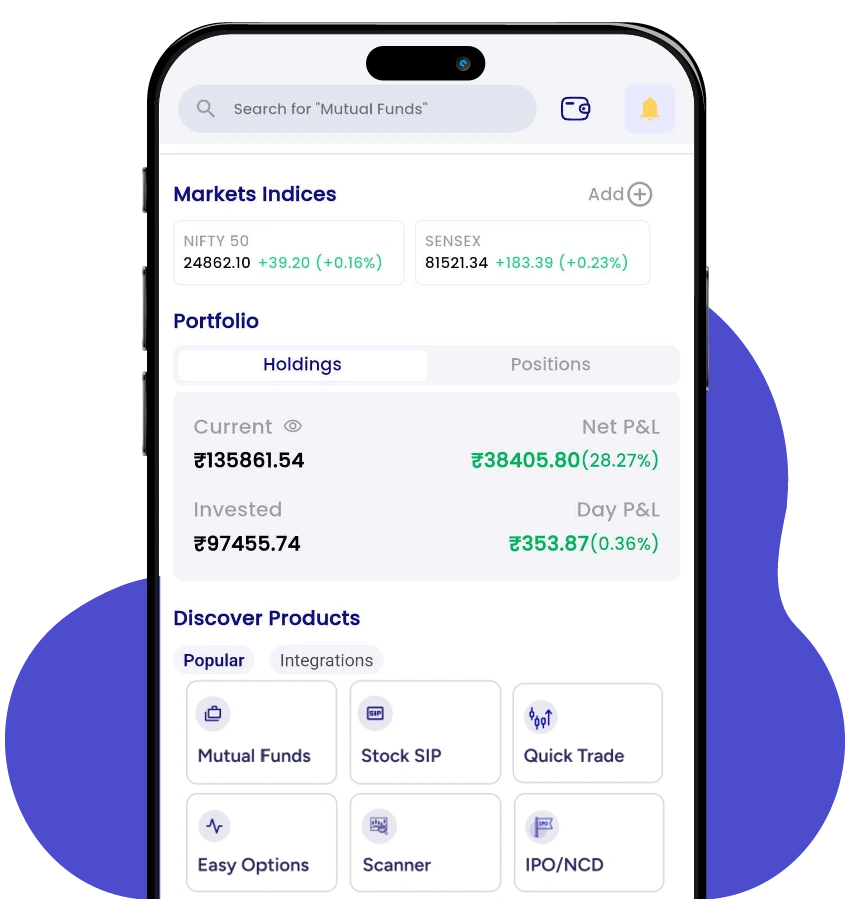What is Options Trading?
- 16th July 2025
- 10 min read
Ever wondered how some traders protect their portfolios in adverse market conditions? Some of them use options trading and just speculate on the future movements of particular securities. This helps them to gain substantial returns with limited capital. However, while offering high returns, options are extremely risky. That is why clarity must be prioritised in this type of investment.
Read this blog to get a clear understanding of what is options trading and some strategies that you can use in this trading.
Options Trading Definition
Options are financial derivatives that give the holder the right, but not the obligation, to buy or sell an underlying asset (like stocks, ETFs, or commodities) at a predetermined price (strike price) on or before a specific expiry date.
The Indian derivative market is witnessing substantial growth year by year. According to a Securities and Exchange Board of India (SEBI) report, the proportion of young traders in the future and options segment rose to 43% in FY24.
Traders can gain higher returns from options trading based on the underlying asset’s price movement. As a result, your profitability is affected by market volatility and the strike price, which is explained below.
Terms Related to Options Trading
Now that you know the options trading meaning, let us some related terms of options trading:
-
Strike price
The strike price is the fixed price at which the holder of the option can buy (call) or sell (put) the underlying asset if they choose to exercise the contract.
-
Expiry date
It is the date when the options contract expires. On this day, traders have to decide whether they will exercise the contract at the strike price.
-
Premium
The premium is the price the buyer pays to the seller to acquire the rights conferred by the option contract.
Participants in Options
The participants of options trading are highlighted below:
-
Buyer of an Option
The buyer is the individual who pays the premium for purchasing the rights to exercise his or her option.
-
Seller of an Option
The option seller is an individual who receives a premium from a buyer. An option seller sells or buys an asset if the option buyer exercises it.
-
Call and Put Options
A call option gives the buyer the right, but not the obligation, to buy the underlying asset at the strike price. On the other hand, a put option gives the right, but not the obligation, to sell the asset at the strike price.
How Does Options Trading Function?
Options trading offers you the right but not the obligation to buy or sell any underlying asset at a specific price and time.
For instance, you believe the share price of company X is currently trading at INR 10 and will increase in the next month. You decide to buy a call option at a strike price of INR 20 that expires within a month. You have paid INR 5 for this call option. Either you lose with this call or profit.
- Scenario 1: If the stock price reaches INR 30 before the expiry date, you can exercise your call option at a low price of INR 20. Your profit will be:Current price of stock – strike price – premiumINR (30 – 20 – 5) per share = INR 5 per share
- Scenario 2: If the price does not reach INR 20, you can avoid choosing the exercise options and let it expire. Your loss will be only INR 5, which is the paid premium.
What are the Different Strategies in Option Trading?
While offering higher returns, options trading also poses significant risks to traders. A SEBI member has reported that individuals have lost almost INR 51,869 crores in index derivatives during FY24. Hence, it is extremely crucial to understand each strategy of options trading.
Here are some different option trading strategies you can use:
-
Long Call
A long call strategy allows purchasing a call option, which offers you the right but not the obligation to buy the asset at a predetermined price before or on the expiry date. You may use this strategy when you can estimate that the price of assets will rise significantly.
-
Short Call
A short call allows you to sell a call option without owning the underlying asset. You are obligated to sell the underlying asset once the buyer exercises their right. You can use this strategy when you believe the price of the underlying asset will remain relatively the same or decrease.
-
Long Puts
This strategy allows you to buy a put option, which enables you to sell the underlying asset at the strike price. If you anticipate a drop in the asset price, you can use this long put strategy.
-
Short Puts
A short put allows you to sell a put option without owning the underlying asset. You are obligated to purchase the asset at the strike price if the buyer exercises their right. This strategy can benefit you when you believe the price of the asset will increase or remain relatively stable.
-
Long Straddle
A long straddle strategy can be beneficial for you when you expect significant price movements in the underlying asset but are uncertain about its direction. This strategy includes simultaneously buying a call and put option at the same strike price and expiry date.
-
Short Straddle
This is just the opposite strategy of a long straddle, as it allows you to sell both call and put options at the same price and expiration date. This strategy is suitable for you when you expect the underlying asset’s price to remain relatively stable in a particular range.
Profitability Scenarios in Options Trading
There are primarily three profitability scenarios in options trading:
-
In-the-Money Option
This profitability scenario results in positive cash flow to the holder if it is immediately exercised. For instance, an in-the-money option situation will arise if the spot price is higher than the strike price.
-
At-the-Money Option
An at-the-money option scenario leads to zero cash flow. It means there will be neither a loss nor a profit if options are exercised immediately. If the strike price remains equal to the current index value, the option will be considered at-the-money.
-
Out-of-the-Money Option
This scenario leads to negative cash flow if the options were exercised immediately. For instance, an out-of-the-money option scenario will arise if the spot price is lower than the strike price.
How Option Trading is Different From Other Instruments?
Before you invest in options, you must know how it is different from other instruments. The primary difference is that options contracts offer you high flexibility, which helps you to select different types of variables, including expiration date and strike price.
Although instruments like stocks carry high risks, risks in options are significantly higher. Investors with a low risk appetite may not be suitable for this investment type.
In addition, since traders should correctly predict the direction of price movements, they must prioritise comprehensive market knowledge and good timing.
Benefits of Option Trading
Here are some benefits you can get while performing options trading efficiently:
- Compared to other securities, options trading can offer higher returns if performed correctly. You can profit from both upward and downward price movements of an underlying asset.
- Options are also considered a valuable tool for hedging that allows traders to minimise risks.
- Options trading also offers you flexible strategies which can be profitable under any market condition. Based on your risk tolerance and needs, you can customise your trades.
- Since they are leveraged, options contracts allow traders to trade with more money than they have.
You can open a Demat account for free using the PL Capital Group – Prabhudas Lilladher application. It helps you trade in future and options with research-backed recommendations.
Limitations of Options Trading
While there are numerous benefits of options trading, it also has different limitations that you need to know:
- The primary limitation of option trading is that beginners may find it difficult to understand the options-related jargon.
- Option trading is extremely risky, despite offering higher returns. Option buyers may lose their total capital, while sellers may face unlimited losses.
- The volatility of option trading can result in fluctuations in the premium.
- Options trading requires constant monitoring, which reduces the time to conduct effective research on other securities.
Final Words
With the rising popularity of options trading in the Indian stock market, understanding what is options trading has become extremely crucial. Options trading allows you to trade any securities at a predetermined price and within a certain time frame. However, you must also be aware of the risks related to options trading to avoid huge losses.
Opening a Demat account with PL Capital can help you invest in options and other derivatives. Download the PL Capital application to understand more advanced trading services!
Frequently Asked Questions
1. How to Perform Option Trading?
You need to open a Demat and trading account first to perform options trading. Then choose the option you want to buy, and then predict the strike price.
2. Which one is better between option trading and stock trading?
Both stock trading and option trading have distinct features. If done correctly, option trading can offer you substantial returns. However, option trading includes higher risk compared to stocks.
3. What is an option trading with an example?
Options trading allows traders to buy or sell securities at a set price within a specific timeframe. For example, if you buy a call option at INR 105 with an INR 20 premium, and the stock rises above INR 105, you profit. If it stays below, you avoid exercising the option, limiting your loss to the premium paid.
4. What are two different types of options?
Call options and put options are two different types of options. A call option gives you the right but not the obligation to purchase an underlying asset at a predetermined price. On the other hand, put options offer you the right but not the obligation to sell assets at specific rates and dates.
5. Why do investors trade options?
Investors trade options to avail numerous benefits like higher returns, flexible strategies, and minimise the risk.





